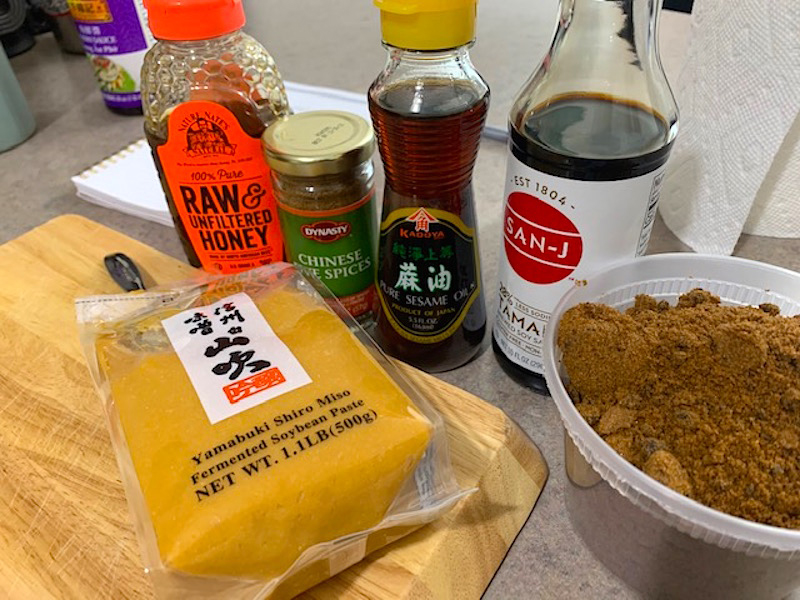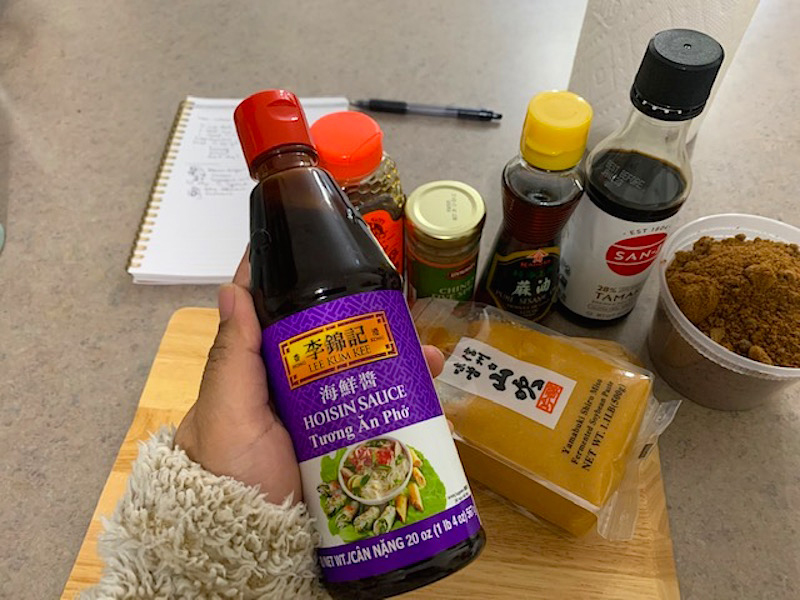PHOTOS BY CHANDRA WALBOLT
This column is underwritten with generous support from United Noodles, Minnesota’s largest Asian grocery store, awarded “Best International Grocery” by City Pages in 2014, 2016, and 2020. Chandra Walbolt is a professional chef with experience at several restaurants in the Twin Cities, and she currently serves as a manager at Union Hmong Kitchen. She will soon be the Executive Sous Chef at Yia Vang’s Vinai in Northeast Minneapolis.
Hoisin sauce is thick like molasses. It’s sweet and savory, and adds richness and depth. It’s most commonly seen used in pho and Asian BBQ marinades like char siu or Peking duck. Stir fries also balance well with hoisin. Strong in flavor and sweetness, a little bit goes a long way.
Growing up I thought I could use hoisin and oyster sauce interchangeably. They look nearly identical. If you had this same theory, you may have found that they are NOT the same. Oyster sauce is saltier and umami packed with a touch of sweetness. Oyster sauce is made of ground up oysters whereas hoisin is made from fermented soybeans with addition of spices, sugars and thickening agents. So you’ll find a more similar taste between soy sauce and hoisin rather than oyster sauce and hoisin. Most hoisin contains wheat flour as a thickener, so keep an eye out if you have a gluten intolerance!
 Soy sauce can be used as a substitute for hoisin – you’ll need to add a sweetener and you won’t have the same consistency, resulting in a runnier product. But no worries, I’ve developed a hoisin-style sauce that mimics the viscosity and intensity that store-bought hoisin presents.
Soy sauce can be used as a substitute for hoisin – you’ll need to add a sweetener and you won’t have the same consistency, resulting in a runnier product. But no worries, I’ve developed a hoisin-style sauce that mimics the viscosity and intensity that store-bought hoisin presents.
The name “hoisin” is derived from the Cantonese language, “hoi” meaning “sea”, and “sin” meaning “fresh”. Oddly enough, this condiment contains no seafood and is also hardly ever eaten with seafood. The intense flavor clashes with the delicate flavor of most seafoods. So why call it hoisin? The best theory I could find is that the sauce originated in a small area of China, where it was eaten with fresh oysters, and as the condiment migrated into different regions the use for it changed and developed. Hoisin also gives off a hint of fish sauce-like umami flavor, so that could also be a factor in the name.
Hoisin can be found in most general grocery stores by the soy sauces. Lee Kum Kee is a tried and true brand I see used most in restaurants and homes. It can be stored at room temp, but I would suggest refrigeration after opening to keep it fresher for longer, especially because usually you’ll only need to use a small amount of hoisin at a time.
I was curious as to how to develop the signature flavor of hoisin without just buying the bottled stuff, and to really get to know all the different flavor elements and how they impact the complexity of the sauce. During research, I’ve seen countless recipes that just say to combine peanut butter, soy sauce, and a sweetener. Off the bat, that just did not sit right with me. Peanut butter has way too strong of a flavor, and although it may mimic the consistency, it’s just not the same. So I did some experimenting to make homemade hoisin flavored sauce!
As much as I would have loved to try fermenting the beans by myself and starting completely from scratch, I don’t have that much knowledge yet. Some day… but for now this will do!
As I tasted my hoisin and store-bought hoisin I really learned how different ingredients really influence the flavor. Miso gives it salty soy sauce flavor without watering down the consistency, sesame oil gives a hint of light toastiness, and honey gives that sweet sticky mouthfeel that makes you suck on your tongue and that is crucial to a good hoisin sauce. This recipe is gluten free and can be vegan!
 HOMEMADE HOISIN
HOMEMADE HOISIN
This recipe yields about 1 cup of sauce.
The equipment you’ll need a small sauce pot and something to stir with.
100g dark brown sugar
80g white miso
4g toasted sesame oil
16g low sodium tamari
20g natural honey or agave
1 tsp Chinese 5-spice
Mix all ingredients together and cook on med-low in a sauce pot to dissolve the sugars. Let cool, and viola! Store in the fridge and use as you would normally use store-bought hoisin, this recipe will just make you feel a lot cooler because you made it yourself.

